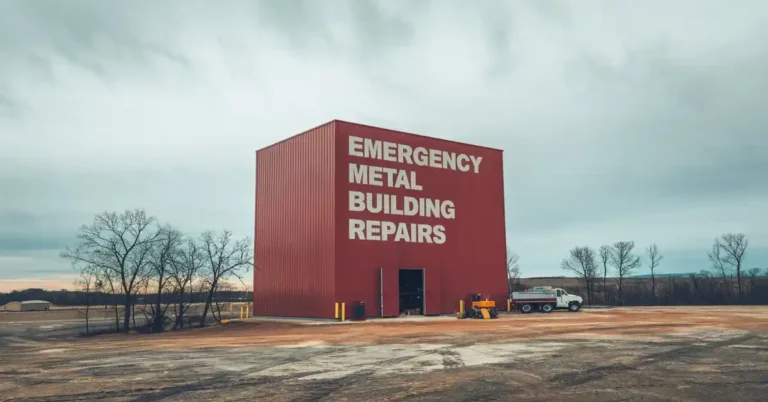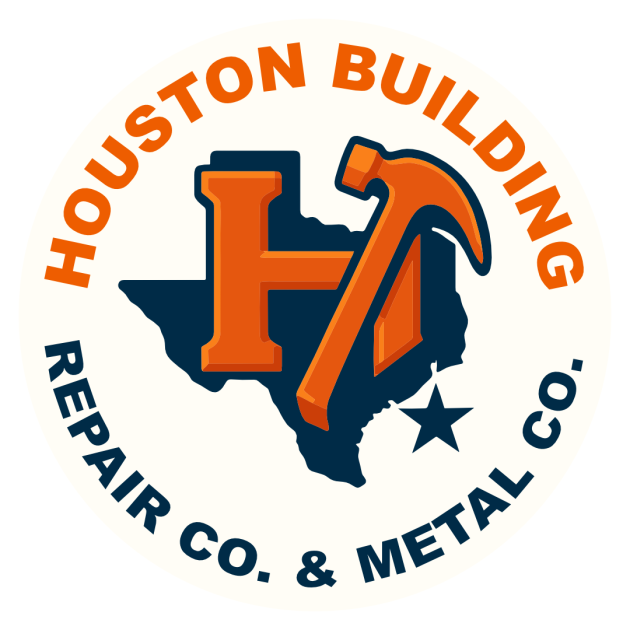Emergency Metal Building Repairs: What to Do After a Collapse or Severe Damage
When a metal building collapses or sustains severe damage, every second counts. Whether it’s due to extreme weather, structural failures, or accidents, knowing how to respond can save lives, minimize property loss, and speed up recovery. Here’s a step-by-step guide to navigating these emergencies safely and effectively.
Immediate Actions to Take After a Collapse or Severe Damage

In the chaotic aftermath of a metal building collapse, your immediate response is critical. Here’s how to take charge and ensure everyone’s safety.
1. Prioritize Safety First
If a collapse occurs, evacuate the area immediately. Heavy debris, exposed metal edges, and unstable structures pose serious risks. Call 911 if anyone is injured or trapped. It is crucial that you do not re-enter the building until professional inspectors have confirmed it’s safe to do so. Furthermore, make sure everyone in the surrounding area is aware of the potential dangers.
2. Secure the Site
Restrict access to the damaged area using barriers or caution tape. Falling debris and hidden hazards—like weakened beams or electrical wires—can cause secondary injuries. If possible, cover holes with tarps to prevent water damage or pests. Securing the site not only prevents further injury, but it also helps to preserve the scene for insurance adjusters and structural engineers.
3. Document the Damage
Take photos or videos of the collapse site from multiple angles. This evidence is crucial for insurance claims and repair planning. Note any visible cracks, bent supports, or corrosion. The more thorough the documentation, the smoother the claims process will be. Be sure to include close-ups and wide shots to provide a comprehensive overview of the damage.
Thoroughly Assessing Structural Integrity
Once the immediate danger is addressed, it’s time to understand the full extent of the damage. A professional assessment is essential for a safe and effective repair strategy.
1. Call in Professionals
A structural engineer or certified inspector should evaluate the building’s stability. They’ll check for:
- Foundation shifts or compromised footings.
- Bent or twisted steel frames that could collapse further.
- Corrosion in beams, bolts, or roofing panels.
Temporary supports, like braces or props, might be installed to stabilize the structure during inspections. Moreover, the engineer will provide a detailed report outlining the extent of the damage and recommending necessary repairs.
2. Identify Hidden Risks
Look for less obvious issues, such as:
- Water damage weakening insulation or electrical systems.
- Asbestos or mold in older buildings.
- Damaged firewalls or safety exits.
Hidden risks can pose significant health and safety hazards, so a comprehensive inspection is essential. This is a time to call in specialists to identify materials that might be dangerous, such as asbestos.
Implementing Temporary Repairs to Prevent Further Damage
While awaiting permanent repairs, it’s essential to take action to prevent further deterioration of your property. These temporary fixes can make a significant difference.
1. Patch Roof Leaks
Use heavy-duty tarps or plastic sheeting to cover holes. Secure them with nails or adhesive tape to prevent wind uplift. For smaller gaps, apply cold-patch roofing material as a quick fix. Preventing water intrusion can save thousands of dollars in secondary damage, such as mold growth and damage to inventory.
2. Reinforce Weak Points
- Tighten loose screws and bolts to stabilize panels.
- Replace missing fasteners to prevent panels from detaching.
- Seal gaps around windows, doors, and vents with silicone caulk.
Reinforcing weak points can prevent further collapse and protect the interior from the elements. This is not a substitute for permanent repairs but a temporary measure to mitigate further damage.
3. Clear Debris Safely
Wear protective gear (gloves, goggles, masks) while removing rubble. Watch for sharp edges, exposed wires, or hazardous materials like asbestos. Safe debris removal is essential to prevent injuries and allow for a more thorough assessment of the damage. It’s crucial to follow safety protocols and wear appropriate personal protective equipment (PPE).
Effectively Navigating Emergency Metal Building Repairs

Restoring a damaged metal building requires a strategic approach and the right expertise. Here’s how to navigate the repair process smoothly.
1. Work With Certified Contractors
Choose a repair company experienced in metal structures. They’ll address:
- Roof replacements using durable, weather-resistant panels.
- Frame realignment to restore structural integrity.
- Corrosion treatment to halt rust spread.
Certified contractors have the expertise and equipment to handle complex metal building repairs safely and effectively. Check their credentials, read reviews, and ask for references before hiring.
2. Coordinate With Insurance
Notify your insurer immediately. Provide documentation (photos, repair estimates, incident reports) to streamline claims. Some policies cover temporary housing or equipment relocation. Understanding your insurance coverage and working closely with your adjuster can expedite the claims process. Keep detailed records of all communication and expenses.
3. Plan for Long-Term Solutions
- Upgrade insulation to improve energy efficiency and prevent condensation.
- Install reinforced bracing in high-wind or seismic zones.
- Schedule annual inspections to catch issues early.
Planning for long-term solutions ensures the building’s resilience and longevity. Consider upgrades that not only repair the damage but also enhance the building’s performance and durability.
Steps to Preventing Future Collapses: Emergency Metal Building Repairs
Prevention is always better than cure, especially when it comes to structural integrity. Learn how to minimize the risk of future incidents with these proactive measures.
1. Regular Maintenance Matters
- Inspect roofs and walls twice yearly for rust, loose fasteners, or sealant failures.
- Clean gutters to avoid water pooling and corrosion.
- Trim nearby trees to reduce debris buildup during storms.
Regular maintenance is the cornerstone of preventing future collapses. A proactive approach can identify and address potential issues before they escalate into major problems.
2. Address Warning Signs Promptly
Don’t ignore:
- Sagging roofs or uneven floors.
- Unusual noises (creaking, popping) during storms.
- Cracks in foundations or welds.
Ignoring warning signs can have catastrophic consequences. Prompt action can save lives and prevent significant property damage.
3. Invest in Preventative Upgrades
- Retrofit older buildings with hurricane clips or seismic bracing.
- Apply anti-corrosion coatings to extend the structure’s lifespan.
Investing in preventative upgrades enhances the building’s structural integrity and reduces the risk of future collapses. These upgrades can be cost-effective in the long run by preventing costly repairs and downtime.
What Emergency Metal Building Repairs Entail
Emergency Metal Building Repairs encompass a wide range of services aimed at quickly restoring the safety and functionality of a damaged structure. These repairs often include:
- Structural Stabilization: Reinforcing or replacing damaged support beams, columns, and frames to prevent further collapse.
- Roof and Wall Panel Replacement: Replacing damaged or missing panels to protect the interior from the elements.
- Water Damage Mitigation: Removing standing water, drying out affected areas, and preventing mold growth.
- Electrical Repairs: Addressing damaged wiring, electrical panels, and lighting systems.
- Debris Removal: Safely removing debris and hazardous materials from the site.
- Temporary Enclosures: Constructing temporary walls or roofs to secure the building and protect its contents.
The Importance of Choosing the Right Contractor
The success of your repair project depends heavily on the contractor you select. Choosing wisely will ensure the job is done safely, efficiently, and to the highest standards.
Selecting the right contractor for emergency metal building repairs is crucial for ensuring a successful outcome. Consider the following factors when making your decision:
- Experience: Look for a contractor with a proven track record of completing similar projects safely and efficiently.
- Certifications: Verify that the contractor holds the necessary licenses and certifications for performing metal building repairs.
- Insurance: Ensure that the contractor has adequate insurance coverage to protect you from liability in case of accidents or property damage.
- References: Ask for references from previous clients and check online reviews to assess the contractor’s reputation.
- Response Time: Choose a contractor who can respond quickly to your emergency and provide timely repairs.
Let Houston Building Repair Company Restore Your Metal Building
A collapse or major damage doesn’t have to mean starting from scratch. Our team at Houston Building Repair Company specializes in emergency metal building repairs, combining speed with precision to restore safety and functionality. From stabilizing structures to replacing entire roofs, we handle every step—including working with insurers to ease the process.
Don’t wait for small issues to become disasters. If your metal building shows signs of wear or has suffered severe damage, contact us today for a free assessment. We’re here to help you rebuild stronger and smarter.
Need urgent help? Call our 24/7 emergency line at 8325061574. Your safety is our priority.


